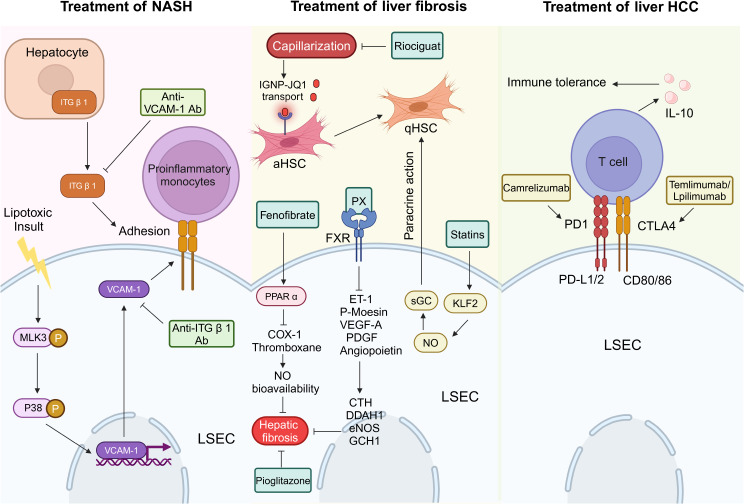Fig. 7.
Treatment of LSECs in liver diseases. ITG β1 from hepatocytes and VCAM-1 from LSECs mediate the recruitment and adhesion of monocytes to LSECs in the development of MASH, so blocking ITG β1 or VCAM-1 can reduce liver inflammation and may be a new therapeutic strategy for MASH. Statins up-regulate KLF2 in LSECs. KLF2 induces HSCs inactivation through paracrine mechanism mediated by KLF2/NO/sGC signal, thus improving hepatic endothelial function and hepatic fibrosis. Fenofibrate can reduce the production of COX-1 and thromboxane, increase the bioavailability of NO in LSECs, reduce hepatic fibrosis and improve hepatic endothelial dysfunction by activating PPARα. In addition, pioglitazone is also beneficial in patients with advanced fibrosis. PX is a novel non-steroidal selective FXR agonist, which can induce hepatic sinusoidal vasodilation (CTH, DDAH1, eNOS and GCH1 up-regulated) and reduce intrahepatic vasoconstriction (ET-1, p-Moesin, VEGF-A, PDGF and angiopoietin down-regulated), thus improving endothelial dysfunction. Newly discovered, Riociguat can reverse sinusoidal capillarization and maintain relatively normal LSECs porosity, thereby promoting the transport of IGNP-JQ1 through the sinusoidal endothelial wall, which is then selectively absorbed by aHSCs in the Disse space to reduce collagen deposition in the liver. Regarding the treatment of HCC, Camrelizumab and Temlimumab /Lpilimumab can target PD1 and CTLA4 on T cells separately, thus inhibiting the secretion of IL-10 and immune tolerance

